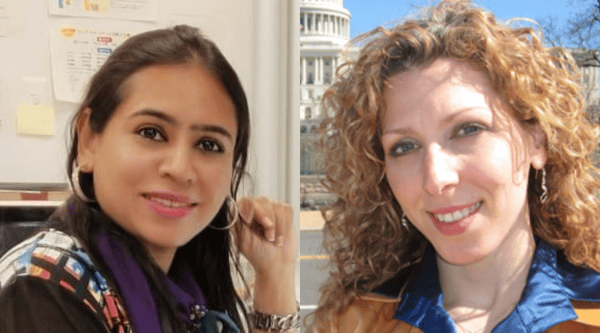.png)
Blog: Female Pioneers in Bioinformatics
Since its emergence as a scientific field in the 1960s, bioinformatics has had a profound impact on genomic medicine. The creation of the field started a scientific revolution, allowing researchers to analyze and interpret vast amounts of biological data generated from experiments and studies in a fraction of the time. Many people don't realize, however, that bioinformatics was invented by women.
The Mother of Bioinformatics: Margaret Dayhoff
The concept of bioinformatics was introduced in 1965 when Professor Margaret Dayhoff (1925-1983) published a book titled Atlas of Protein Sequence and Structure. Dayhoff was a pioneering biochemist and biophysicist and is often referred to as the "mother of bioinformatics" due to her groundbreaking work in the development of computational methods for studying biological molecules. She didn’t know it at the time, but her book would ultimately become the foundation of bioinformatics as it is known today.
 Margaret Dayhoff (1925-1983)
Margaret Dayhoff (1925-1983)
Born in Philadelphia, Pennsylvania in 1925, Dayhoff earned her undergraduate degree in chemistry from Gettysburg College in 1945 and went on to earn a PhD in biophysics from Columbia University in 1950. Following her PhD, Dayhoff worked as a research scientist at the National Institutes of Health (NIH) for several years, focusing on the structure and function of proteins. Her interest focused primarily on developing methods for comparing protein sequences to identify similarities and differences between them. At the time, this was a difficult task because the amount of data was growing exponentially but there were no computational bioinformatic tools available for analyzing it.
In 1965, Dayhoff published the Atlas of Protein Sequence and Structure, also known as the Dayhoff matrix or PAM (Point Accepted Mutation) matrix. The method was a breakthrough for the medical field, allowing researchers to quickly analyze large amounts of data using minimal amounts of time. The original publication of the book featured an encoding of amino acids that Dayhoff found after applying computer technologies to find solutions to biological questions, laying the foundation for bioinformatics as it is known today. Her book is also arguably the first women-led bioinformatics undertaking as, in addition to being written by a woman, all but one of the editors and collaborators in Dayhoff’s Atlas were also women.
Although founding an entire medical field is in and of itself a huge accomplishment, Dayhoff’s contributions to genomic medicine did not stop there. She also founded the National Biomedical Research Foundation in 1974, which was dedicated to the development of databases and software tools for the analysis of biological data, paving the way for modern bioinformatics solutions such as g.nome® . She was also the first woman to hold office in the Biophysical Society.
Nearly 20 years after the original publication of Dayhoff’s book, the National Biomedical Research Foundation launched the Protein Information Resource, an online database that, today, houses over 283,000 protein sequences. Dayhoff’s work unlocked then-modern science tools that are still used today to analyze protein sequences.
The Name of the Game: Paulien Hogeweg
While the concept of bioinformatics was introduced by Dayhoff in 1965, there was no official name until 1970, when Dutch biologist Paulien Hogeweg coined the term with her partner, Ben Hesper.
Hogeweg earned her master’s degree from the University of Amsterdam in 1969, studying biological systems as information processing systems at multiple, interconnected levels.
 Paulien Hogeweg circa 2016
Paulien Hogeweg circa 2016
Following the receipt of her master’s degree, Hogeweg began volunteering in a lab at Leiden University. During this time, she met Hesper, and the two of them created the term for bioinformatics, which they defined as “the study of information processes in biotic systems”. Hogeweg and Hesper later opened a research lab dedicated to bioinformatics in 1977.
Women in the Field Today
Since the conception of the field of bioinformatics, the rise of women within the industry has been slow but steady. In the past decade, the percentage of female bioinformaticians rose from 15 to 18 percent, with the number continuing around the world. Although there are many female bioinformaticians worth noting, we’re shining the spotlight on two.
Dr. Uzma Saqib of Israel is a scientist who specializes in bioinformatics, entering the world of biochemistry and biotechnology after she was unable to become a physician. Her passion for the field led to work with the Central Drug Research Institute, the American Heart Association, and many more. Currently, Dr. Saqib is working in Israel at the University of Haifa, Israel, developing an anti-cancer drug.
 Left: Dr. Uzma Saqib | Right: Dr. Heather Hoffman
Left: Dr. Uzma Saqib | Right: Dr. Heather Hoffman
Dr. Heather Hoffman serves as a professor and vice chair of the Department of Biostatistics and Bioinformatics in the Milken Institute of Public Health and George Washington University, as well as a volunteer teacher, teaching young girls about science. Hoffman’s research primarily focuses on HIV/AIDS, breast cancer, and education innovation. Contributing to multiple publications that focus on each of these topics has led to her being another female trailblazer in the field.
The field of bioinformatics changes daily, with scientists and bioinformaticians discovering new ways to analyze and interpret data for medical breakthroughs, including drug discovery and personalized medicine. These types of discovery can be achieved quickly with new bioinformatic software, such as g.nome® from Almaden Genomics. g.nome accelerates genomic discovery using a cloud-native platform designed to streamline genomic workflows. By using g.nome’s intuitive drag-and-drop pipeline builder, pre-built workflows, and available open-source tools, research teams can spend less time on infrastructure and setup and more time making bioinformatic breakthroughs.